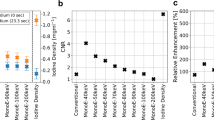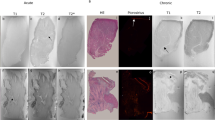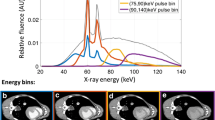Abstract
Objectives
To evaluate the capability of spectral CT imaging to detect the different stages and angiogenesis of myocardial infarction (MI).
Methods
MI was surgically induced in 40 rabbits that were evenly divided into four stages of MI: 6 h (6H), 3 days (3D), 7 days (7D) and 14 days (14D). Spectral CT was performed at 10 s, 1 min and 3 min after intravenous contrast medium administration. CD31 immunohistochemistry was used for the microvessel density (MVD) measurement. Iodine concentrations in the myocardium were measured and normalised to the aorta as nIC. The relationships between infarcted myocardial nIC and MVD were analysed.
Results
The nIC of infarct myocardium decreased at 10 s and increased in late-phase CT images. There were significant differences between the 6H and other groups (P 6H–3D = 0.01, P 6H–7D = 0.01, P 6H–14D = 0.00). There was a significant difference in the MVD of infarct myocardium between the two groups except in the 7D and 14D groups (P = 0.08). In the 10-s phase, the nIC of infarct myocardium was negatively correlated with MVD (r = -0.54, P = 0.00), whereas in the late phases, there was a positive correlation between them (r = 0.57, P = 0.00 in the 1-min phase, r = 0.48, P = 0.00 in the 3-min phase).
Conclusion
Spectral CT imaging of the myocardium can be used to evaluate the different stages and angiogenesis of MI.
Key Points
• Multidetector CT is increasingly used to evaluate the heart.
• Spectral CT offers increased opportunities to assess the myocardium.
• In animals, spectral CT can evaluate different stages of myocardial infarction.
• Spectral CT findings correlated with the angiogenesis of myocardial infarction.
• Spectral CT can reflect dynamic changes of MI at low radiation doses.



Similar content being viewed by others
References
Roger VL, Go AS, Lloyd-Jones DM et al (2011) Executive summary: heart disease and stroke statistics–2011 update: a report from the American Heart Association. Circulation 123:459–463
Cai L, Johnstone BH, Cook TG et al (2009) IFATS collection: human adipose tissue-derived stem cells induce angiogenesis and nerve sprouting following myocardial infarction, in conjunction with potent preservation of cardiac function. Stem Cells 27:230–237
Siragusa M, Katare R, Meloni M et al (2010) Involvement of phosphoinositide 3-kinase γ in angiogenesis and healing of experimental myocardial infarction in mice. Circ Res 106:757–768
Meoli DF, Sadeghi MM, Krassilnikova S (2004) Noninvasive imaging of myocardial angiogenesis following experimental myocardial infarction. J Clin Invest 113:1684–1691
Mahnken AH (2011) Computed tomography imaging in myocardial infarction. Expert Rev Cardiovasc Ther 9:211–221
Schuetz GM, Zacharopoulou NM, Schlattmann P et al (2010) Meta-analysis: noninvasive coronary angiography using computed tomography versus magnetic resonance imaging. Ann Intern Med 152:167–177
Sayyed SH, Cassidy MM, Hadi MA (2009) Use of multidetector computed tomography for evaluation of global and regional left ventricular function. J Cardiovasc Comput Tomogr 3:S23–S34
Ruzsics B, Schwarz F, Schoepf UJ et al (2009) Comparison of dual-energy CT of the heart with single photon emission CT for assessment of coronary artery stenosis and of the myocardial blood supply. Am J Cardiol 104:318–326
Deseive S, Bauer RW, Lehmann R et al (2011) Dual-energy computed tomography for the detection of late enhancement in reperfused chronic infarction: a comparison to magnetic resonance imaging and histopathology in a porcine model. Invest Radiol 46:450–456
Blankstein R, Shturman L, Rogers I et al (2009) Adenosine induced stress myocardial perfusion imaging using dual source cardiac computed tomography. J Am Coll Cardiol 54:1072–1084
Okada DR, Ghoshhajra BB, Blankstein R et al (2010) Direct comparison of rest and adenosine stress myocardial perfusion CT with rest and stress SPECT. J Nucl Cardiol 17:27–37
Rubinshtein R, Miller TD, Williamson EE et al (2009) Detection of myocardial infarction by dual-source coronary computed tomography angiography using quantitated myocardial scintigraphy as the reference standard. Heart 95:1419–1422
Bauer RW, Kerl JM, Fischer N et al (2010) Dual-energy CT for the assessment of chronic myocardial infarction in patients with chronic coronary artery disease: comparison with 3-T MRI. AJR Am J Roentgenol 195:639–646
Mahnken AH, Jost G, Bruners P et al (2009) Multidetector computed tomography (MDCT) evaluation of myocardial viability: intraindividual comparison of monomeric vs. dimeric contrast media in a rabbit model. Eur Radiol 19:290–297
Brodoefel H, Klumpp B, Reimann A et al (2007) Sixty-four-MSCT in the characterization of porcine acute and subacute myocardial infarction: determination of transmurality in comparison to magnetic resonance imaging and histopathology. Eur J Radiol 62:235–246
Brodoefel H, Klumpp B, Reimann A et al (2007) Late myocardial enhancement assessed by 64-MSCT in reperfused porcine myocardial infarction: diagnostic accuracy of low-dose CT protocols in comparison with magnetic resonance imaging. Eur Radiol 17:475–483
Zhang LJ, Peng J, Wu SY, Yeh BM, Zhou CS, Lu GM (2010) Dual source dual-energy computed tomography of acute myocardial infarction: correlation with histopathologic findings in a canine model. Invest Radiol 45:290–297
Kerl JM, Deseive S, Tandi C et al (2011) Dual energy CT for the assessment of reperfused chronic infarction—a feasibility study in a porcine model. Acta Radiol 52:834–839
Lv PJ, Lin XZ, Li JY et al (2011) Differentiation of small hepatic hemangioma from small hepatocellular carcinoma: recently introduced spectral CT method. Radiology 259:720–729
Hara A, Pavlicek W, Silva A (2010) Automated liver lesion characterization using fast kVp switching dual energy computed tomography imaging. Proc SPIE 7624. doi:10.1117/12.844059
Zhao LQ, He W, Li JY et al (2011) Improving image quality in portal venography with spectral CT imaging. Eur J Radiol. doi:10.1016/j.ejrad.2011.02.063
Springer ML (2010) Assessment of myocardial angiogenesis and vascularity in small animal models. Methods Mol Biol 660:149–167
Fujita M, Morimoto Y, Ishihara M et al (2004) A new rabbit model of myocardial infarction without endotracheal intubation. J Surg Res 116:124–128
Park JM, Choe YH, Chang S et al (2004) Usefulness of Multidetector-row CT in the evaluation of reperfused myocardial infarction in a rabbit model. Korean J Radiol 5:19–24
Mahnken AH, Bruners P, Kinzel S et al (2007) Late-phase MSCT in the different stages of myocardial infarction: animal experiments. Eur Radiol 17:2310–2317
Chiou KR, Huang WC, Peng NJ et al (2009) Dual-phase multi-detector computed tomography assesses jeopardized and infracted myocardium subtending infarct-related artery early after acute myocardial infarction. Heart 95:1495–1501
Lardo AC, Cordeiro MAS, Silva C et al (2006) Contrast-enhanced multidetector computed tomography viability imaging after myocardial infarction characterization of myocyte death, microvascular obstruction, and chronic Scar. Circulation 113:394–404
Lessic J, Drgau R, Mutlak D et al (2007) Is functional improvement after myocardial infarction predicted with myocardial enhancement patterns at multidetector CT? Radiology 244:736–744
Gerber BL, Belge B, Legros GJ et al (2006) Characterization of acute and chronic myocardial infarcts by multidetector computed tomography: comparison with contrast-enhanced magnetic resonance. Circulation 113:823–833
Naresh NK, Ben-Mordechai T, Leor J et al (2011) Molecular imaging of healing after myocardial infarction. Curr Cardiovasc Imaging Rep 4:63–76
Acknowledgments
The authors wish to thank Dr. Li Jianying for his technical support in understanding the dual energy spectral CT imaging mode and in editing the manuscript. We specially thank Hai-peng Dong, Zhen-fang Wu, Wei-ping Shi, He-shi Liu, Rui Chang and Meng-xiong Wu for their important contributions.
Author information
Authors and Affiliations
Corresponding author
Rights and permissions
About this article
Cite this article
Pang, Lf., Zhang, H., Lu, W. et al. Spectral CT imaging of myocardial infarction: preliminary animal experience. Eur Radiol 23, 133–138 (2013). https://doi.org/10.1007/s00330-012-2560-9
Received:
Accepted:
Published:
Issue Date:
DOI: https://doi.org/10.1007/s00330-012-2560-9




